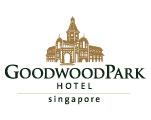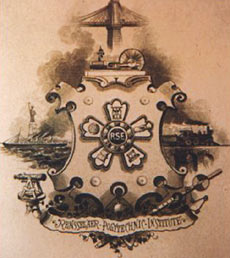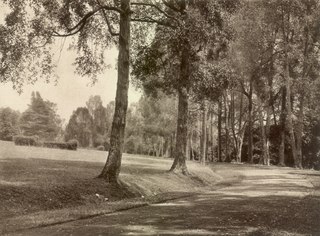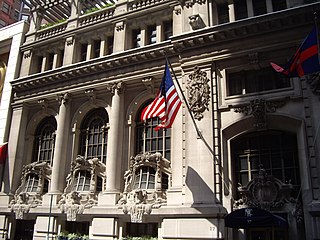
The Goodwood Park Hotel is a heritage hotel in Singapore, situated in a 6-hectare landscaped garden on Scotts Road. It was first built as the club house for the Teutonic Club serving the expatriate German community in Singapore, and later converted into a hotel.

The University Club of New York is a private social club at 1 West 54th Street and Fifth Avenue in the Midtown Manhattan neighborhood of New York City. Founded to celebrate the union of social duty and intellectual life, the club was chartered in 1865 for the "promotion of literature and art". The club is not affiliated with any other University Club or college alumni clubs. According to The New York Times, the club is considered one of the most prestigious in New York City.

The Lensbury is a conference centre, hotel, and leisure facility located on the banks of the Thames in Teddington, in the London Borough of Richmond upon Thames. The Lensbury was founded in 1920, as a club for employees of the oil company Shell and was known as the "Lensbury Club" until the 1990s.

The Jekyll Island Club was a private club on Jekyll Island, on Georgia's Atlantic coast. It was founded in 1886 when members of an incorporated hunting and recreational club purchased the island for $125,000 from John Eugene du Bignon. The original design of the Jekyll Island Clubhouse, with its signature turret, was completed in January 1888. The club thrived through the early 20th century; its members came from many of the world's wealthiest families, most notably the Morgans, Rockefellers, and Vanderbilts. The club closed at the end of the 1942 season due to complications from World War II.

The Rensselaer Society of Engineers (RSE) is a social fraternity founded in 1866 at Rensselaer Polytechnic Institute in Troy, NY. Originally named The Pi Eta Scientific Society, the organization was incorporated in 1873 in the state of New York. Arriving on campus at about the same time as some of the first fraternities, it has remained one of the oldest "local" organizations in the U.S. RSE is the only independent fraternity at Rensselaer. They have chosen to remain independent to maintain the freedom to set their own policies and make their own managerial decisions. Contrary to what their name may imply, members major not only in engineering, but also in such disciplines as science, management, architecture, and the arts. Society members are active in not only campus and local activities, but are also in many national organizations.

The Players is a private social club founded in New York City by the noted 19th-century Shakespearean actor Edwin Booth.

The Harvard Club of New York City, commonly called The Harvard Club, is a private social club located in Midtown Manhattan, New York City. Its membership is limited to alumni, faculty and board members of Harvard University.

The Down Town Association in the City of New York, usually referred to as the Down Town Association or the DTA, for short, is a private club in the Financial District of Manhattan, New York City.

The Metropolitan Club is a private social club on the Upper East Side of Manhattan in New York City, United States. It was founded as a gentlemen's club in March 1891 by a group of wealthy New Yorkers led by the financier John Pierpont Morgan. The clubhouse at Fifth Avenue and 60th Street was designed by McKim, Mead & White and is a New York City designated landmark. The club is controlled by a 25-member board of governors. Initially, only men could become members, though women were given membership privileges in the mid-20th century. Like other Gilded Age social clubs, the Metropolitan Club functioned largely as a meeting place for the wealthy, hosting events such as luncheons, dinners, debutante balls, and business meetings.

The Athenaeum is a gentlemen's club in London, founded in 1824. It is primarily a club for men and women with intellectual interests, and particularly for those who have attained some distinction in science, engineering, literature or the arts. Humphry Davy and Michael Faraday were the first chairman and secretary and 51 Nobel Laureates have been members.
The Taiping Clubs were sports and recreation clubs that existed in the city of Taiping, Malaysia, during the 1880s. At the time, the city saw significant growth in European as well as Chinese, Indian, Arab, and Indonesian communities, and thus the need for such clubs arose. The following is a non-exhaustive list of these establishments.

The Singapore Recreation Club is one of Singapore's oldest social clubs with a strong sporting tradition, located on Connaught Drive at the north end of the Padang in the heart of Singapore's Civic District.

The Missouri Athletic Club, founded in 1903, is a private city and athletic club with two locations. The Downtown Clubhouse is in Downtown St. Louis, Missouri, USA and the West Clubhouse is located in the St. Louis County suburb of Town and Country.

The University Club of Albany, New York, was a social club founded in 1901 that closed in 2022. It was most recently housed in a Colonial Revival brick building at the corner of Washington Avenue and Dove Street.

The Rand Club is a private members' club in Johannesburg, South Africa, founded in October 1887. The current (third) clubhouse was designed by architects Leck & Emley in 1902 and its construction completed in 1904. Cecil John Rhodes helped to select the location.

Cannon Dial Elm Club, also known as Cannon Club, is one of the historic Eating Clubs at Princeton University. Founded in 1895, it completed its current clubhouse in 1910. The club closed in the early 1970s and later merged with Dial Lodge and Elm Club to form Dial, Elm, Cannon (DEC), which closed its doors in 1998. In 2011 DEC reopened, now bearing the name Cannon Dial Elm Club, using its historic clubhouse, which had served as the home for the Office of Population Research during the club's hiatus.

Tyersall Park is an estate in Singapore, bound by Holland Road and Tyersall Avenue, and near the Singapore Botanic Gardens. Previously a private land belonging to the Sultan of Johor from 1862, some portions of it had been acquired by the Government of Singapore in 1990 and in 2009 respectively.

The Manila Polo Club is the premiere polo club in the Philippines. It was established in 1909 during the American colonial era by Governor General William Cameron Forbes as a venue for polo and leisure for the wealthy elite. It was originally located in Pasay prior to World War II, after which it transferred to its present location in Forbes Park, Makati.

The New York Yacht Club Building is a seven-story Beaux-Arts clubhouse at 37 West 44th Street in the Midtown Manhattan neighborhood of New York City. Opened in 1901, the building was designed by architect Whitney Warren of Warren and Wetmore as the sixth clubhouse of the New York Yacht Club (NYYC). The clubhouse is part of Clubhouse Row, a concentration of clubhouses on 44th Street between Fifth and Sixth Avenues. The building is a New York City designated landmark and is listed on the National Register of Historic Places as a National Historic Landmark.

The Vancouver Club is a private social club in Vancouver, British Columbia. The club was founded in 1891 as a gentlemen's club but in 1993 became mixed-sex. Since its inception it has been the city's preeminent private club. For most of its history, the club's membership was restricted to the city's old money, in contrast with the Terminal City Club, which was more open in its membership policies. As with many traditional gentlemen's clubs, the Vancouver Club struggled to attract younger members after the 1960s. Besides becoming mixed-sex, in recent decades the club has abandoned most of its Victorian customs and has become a more informal, business oriented institution.




















